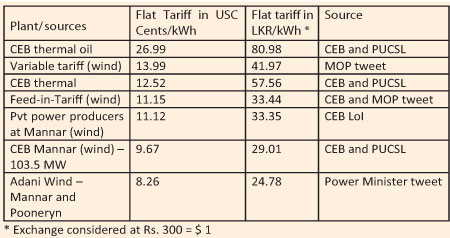Thursday Mar 13, 2025
Thursday Mar 13, 2025
Friday, 7 June 2024 02:50 - - {{hitsCtrl.values.hits}}
 India’s Adani yesterday issued a statement setting the record straight over multiple concerns raised by various stakeholders regarding its wind power project in Sri Lanka.
India’s Adani yesterday issued a statement setting the record straight over multiple concerns raised by various stakeholders regarding its wind power project in Sri Lanka.
Yesterday the Daily FT published a report revealing Transparency International Sri Lanka (TISL) seeking transparency and filing 11 Right to Information (RIT) applications. (See https://www.ft.lk/top-story/TISL-demands-transparency-in-Adani-wind-power-project-Files-11-RIT- applications/26-762668)
In its statement Adani said the proposed wind power project in Sri Lanka has adhered to all requisite due processes and regulatory standards, ensuring that it meets the highest standards of transparency and efficiency.
Regulatory compliance and due process
Competitive tariff rates
The tariff negotiated for Adani’s wind power project is highly competitive, as illustrated in the table below:
Adani’s project, with a tariff of Rs. 24.78 per unit, is notably lower than the tariffs of other renewable energy projects recently approved, and significantly cheaper than fossil fuel-based power generation.
Economic and environmental benefits
1. Foreign direct iinvestment: The project brings in 100% FDI worth $ 1,029 million (approximately Rs. 308.7 billion), broken down as follows:
o Wind plants: $ 741 million (approximately Rs. 222.3 billion)
o Transmission infrastructure: $ 288 million (approximately Rs. 86.4 billion)
2. Employment generation: The project will create over 1,200 jobs, providing a significant boost to the local economy.
3. Green energy production: Generating about 1,500 million units of green power annually, the project will meet the energy needs of 590,000 households and help Sri Lanka achieve its renewable energy target of 70% by 2030. This green energy production will avoid 1.06 million tons of CO2 emissions annually, offering an economic benefit of up to $ 100 million per year.
4. Cost reduction and consumer benefits: Targeted for completion by 2025, the project will reduce the government’s electricity purchase costs by approximately $ 83 million per year (about Rs. 25 billion), leading to a reduction in consumer electricity tariffs by Rs. 17 per unit.
5. Lowest wind tariff: Adani’s wind power tariff of Rs. 24.78 per unit is the lowest in the country, cheaper than the CEB’s 100 MW wind power plant at Thambapavani and significantly lower than oil-based power at Rs. 80 per unit.
6. Foreign exchange savings: By replacing higher-cost, import-dependent fossil fuel power, Adani’s project will save Sri Lanka over $ 270 million annually in foreign exchange, potentially up to $ 5.4 billion over the project’s lifetime.
This project exemplifies Adani’s commitment to fostering sustainable energy solutions while delivering substantial economic and environmental benefits to Sri Lanka in what is Sri Lanka’s biggest fforeign direct iinvestment up to date in history.
Discover Kapruka, the leading online shopping platform in Sri Lanka, where you can conveniently send Gifts and Flowers to your loved ones for any event including Valentine ’s Day. Explore a wide range of popular Shopping Categories on Kapruka, including Toys, Groceries, Electronics, Birthday Cakes, Fruits, Chocolates, Flower Bouquets, Clothing, Watches, Lingerie, Gift Sets and Jewellery. Also if you’re interested in selling with Kapruka, Partner Central by Kapruka is the best solution to start with. Moreover, through Kapruka Global Shop, you can also enjoy the convenience of purchasing products from renowned platforms like Amazon and eBay and have them delivered to Sri Lanka.
Discover Kapruka, the leading online shopping platform in Sri Lanka, where you can conveniently send Gifts and Flowers to your loved ones for any event including Valentine ’s Day. Explore a wide range of popular Shopping Categories on Kapruka, including Toys, Groceries, Electronics, Birthday Cakes, Fruits, Chocolates, Flower Bouquets, Clothing, Watches, Lingerie, Gift Sets and Jewellery. Also if you’re interested in selling with Kapruka, Partner Central by Kapruka is the best solution to start with. Moreover, through Kapruka Global Shop, you can also enjoy the convenience of purchasing products from renowned platforms like Amazon and eBay and have them delivered to Sri Lanka.